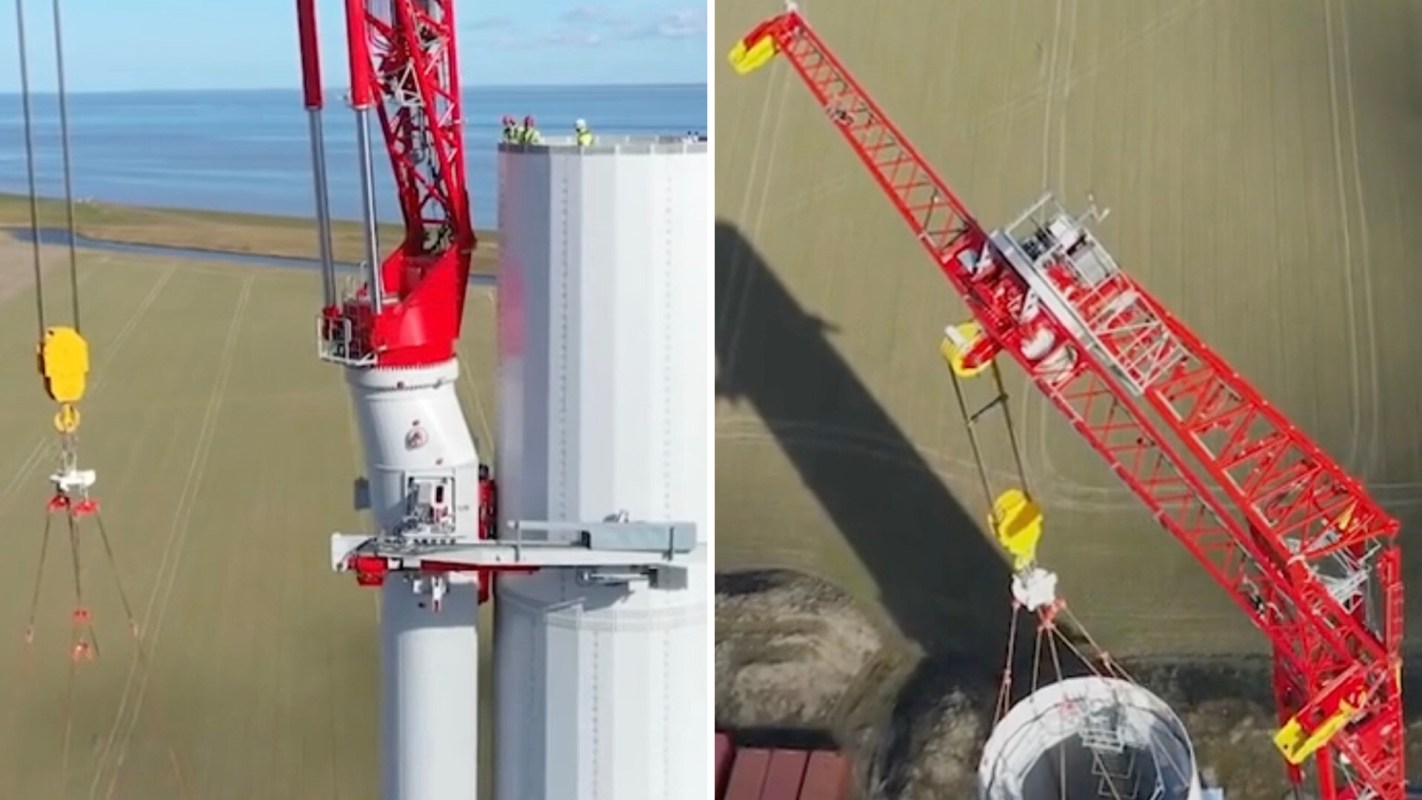The sky is seemingly the limit for clean-energy–producing wind turbines, with the development of a crane that can propel itself up a turbine's column like a skillful coconut palm tree climber.
The ENERCON LCC 140 Climbing Crane is designed to build wind turbines to great heights and in challenging environments. Because it doesn't require a separate tower, it's small relative to other turbine-construction cranes, requires less installation space, and can be transported efficiently and set up or taken down in a day, which saves time, money, and energy.
A TikTok video posted by GiGadgets (@gigadgetsofficial) describes the LCC 140 as a "self-climbing crane" that can install wind turbines up to 590.5 feet tall — almost four times the Statue of Liberty's height (without its base). The crane's name comes from the weight it can lift: 140 metric tons (about 154 tons), or roughly the Statue of Liberty's weight (again, without the base).
@gigadgetsofficial Meet the crane that can climb and install wind turbines up to 590 ft (180m) high while it's being built. ENERCON LCC 140 Climbing Crane is a self-climbing crane that can install wind turbines up to 590.5 feet (180m) high with a maximum hoisting capacity of 154.3 tons (140 tonnes). It was developed by Lagerwey, a subsidiary of German wind turbine manufacturer ENERCON. The LCC 140 was first used in 2019 to install an ENERCON E-136 EP5 wind turbine in the Netherlands. It has since been used to install other ENERCON wind turbines, as well as wind turbines from other manufacturers. #gigadgets #cranelife #windturbine #installer ♬ original sound - GiGadgets
The crane works by wrapping around a cylindrical section of the turbine as it adds the next section above and then hoists itself up. An operator on the ground moves the crane by remote control.
This technology is the invention of Netherlands-based turbine builder Lagerwey, a brand that was acquired and retired by the Germany-based energy company ENERCON. Wind Power Monthly reported that Lagerwey developed the first self-climbing crane concept in 2015–2016.
In recent years, other companies have developed similar climbing devices, such as the Anson Wind Turbine Crane, the Weihua self-climbing crane, and the KoalaLifter — the last of which was inspired by the method koalas have for climbing trees, as GiGadgets reports in a separate TikTok video.
@gigadgetsofficial This system climbs up a wind turbine like a koala to perform maintenance and construction work. KoalaLifter is an autonomous self-climbing crane system for the maintenance and erection of onshore and offshore wind turbines. It's a breakthrough technology inspired by climbing koalas that uses friction collars to climb the tower instead of a conventional crane. The system was developed by Spanish company KoalaLifter, which received a €2 million grant from the European Innovation Council. It offers a more efficient and flexible alternative to traditional methods, and has the potential to make wind energy more affordable and reliable. #gigadgets #robottiktok #windturbine #cranetok #maintenancetips ♬ original sound - GiGadgets
The development of climbing cranes could be significant as wind turbines get taller.
One offshore wind turbine in Chinese waters has a reported turbine hub height of 479 feet. A 919-foot-tall prototype in Denmark recently set records for height and clean energy production.
Although the video description of the LCC 140 Climbing Crane doesn't describe it building to quite that record height, it would still be able to construct turbines ranking among the tallest in the world. Builders have already built turbines in the Netherlands using one of the cranes.
Greater height often allows turbines to have longer blades to catch more wind or to reach stronger winds at greater altitudes. According to the U.S. Energy Information Administration, these factors lead to greater energy output, which is not only good for providing electricity but also for reducing people's dependence on dirty energy for electricity generation.
Replacing old, dirty power plants with wind farms can save communities money while keeping air cleaner.
For example, one giant wind farm off China's coast could produce an amount of energy equal to burning one billion pounds (500,000 tons) of coal and could avoid releasing about three billion pounds (1.36 million tons) of planet-overheating pollution each year.
With technology like the climbing crane already at work building wind turbines high into the skies, those skies up ahead might be a little clearer for us all.
Join our free newsletter for weekly updates on the coolest innovations improving our lives and saving our planet.









